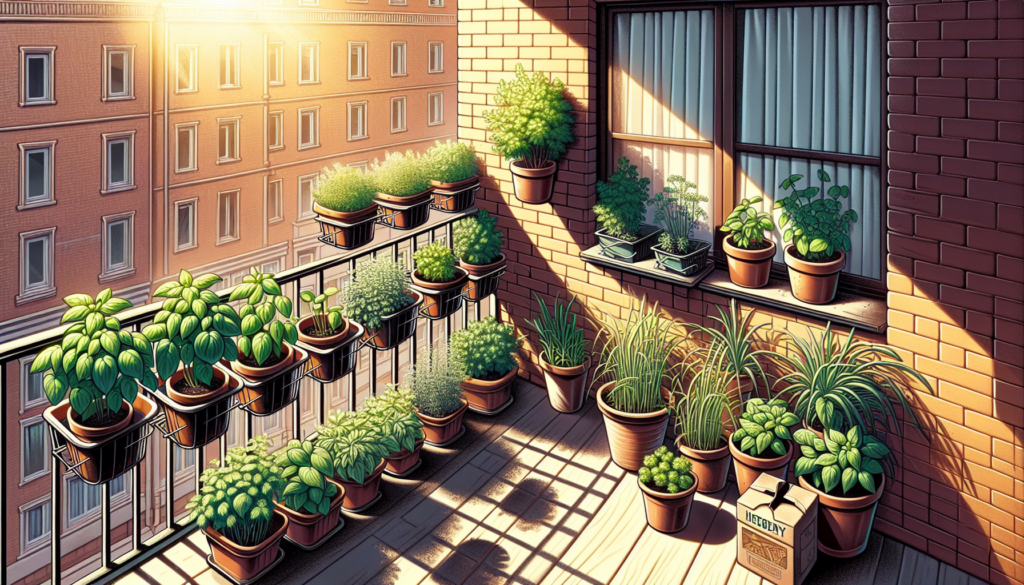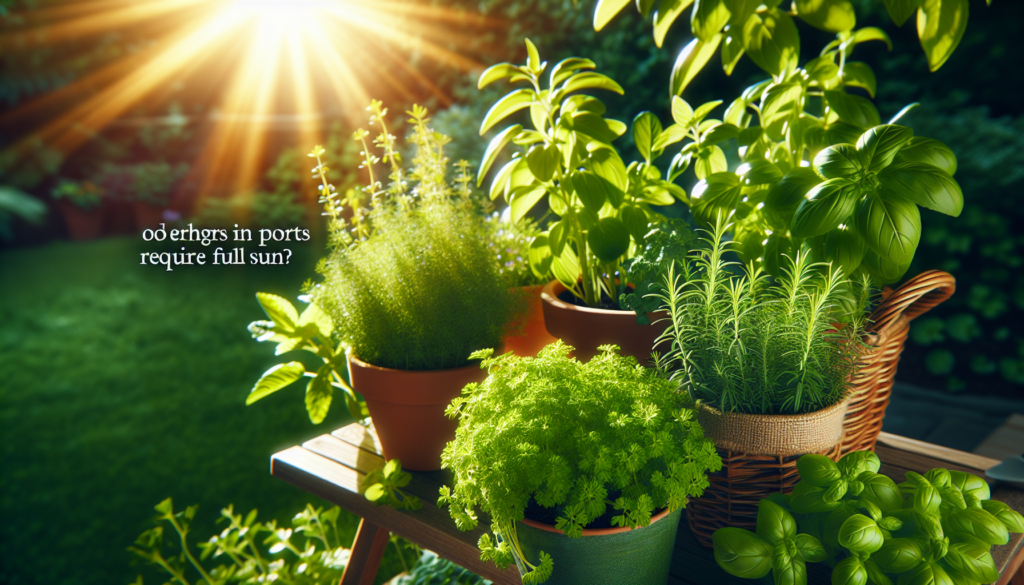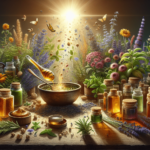So you’ve decided to venture into the world of gardening and want to grow herbs in pots. One burning question on your mind is whether these herbs require full sun or if they can thrive in shadier areas. After all, not everyone has access to a sun-soaked garden. Well, fear not! In this article, we will explore the sunlight requirements of potted herbs and uncover the truth behind their sun-loving nature. Get ready to unlock the secret to growing lush herbs in the comfort of your own home.
Benefits of Growing Herbs in Pots
Flexibility in Placement
When you grow herbs in pots, you have the flexibility to place them wherever you want. Whether you have limited space in your garden or want to keep your herbs close to your kitchen for easy access while cooking, potted herbs are the perfect solution. You can place them on your balcony, windowsill, or even indoors, allowing you to customize their placement according to your needs and the specific requirements of each herb.
Improved Drainage and Soil Control
One of the significant benefits of growing herbs in pots is the improved drainage and soil control. By using well-draining potting soil and pots with drainage holes, you can prevent waterlogging and ensure that excess water drains away. This helps to create an optimal growing environment for your herbs, allowing their roots to thrive and preventing the risk of root rot.
Easy to Maintain and Harvest
Maintaining and harvesting herbs becomes much easier when they are grown in pots. The compact size of pots makes it convenient to care for your herbs, including watering, fertilizing, and pruning. Additionally, when it’s time to harvest your herbs, you can simply pick the leaves or trim the stems without disturbing the entire plant. This makes it easier to enjoy the fresh flavors of your homegrown herbs in your favorite recipes.
Factors to Consider for Herb Growth
Light Requirements
Light is a crucial factor for the healthy growth of herbs. Different herbs have varying light requirements, with some needing full sun, others thriving in partial sun, and a few tolerating shaded areas. Understanding the specific light needs of your herbs is essential for their overall growth and productivity.
Optimal Temperature
Herbs have varying temperature requirements, with some preferring warm conditions while others can withstand colder temperatures. Understanding the optimal temperature range for your herbs will help you choose the right location for their pots and provide the necessary care to ensure their well-being.
Watering Needs
Watering needs vary among different herbs, with some being more drought-tolerant and others requiring consistent moisture. Knowing the specific watering needs of your herbs will enable you to water them appropriately, preventing overwatering or underwatering. This will help maintain the health and vitality of your potted herbs.

Understanding Sunlight Needs for Herbs
Importance of Sunlight for Herb Growth
Sunlight is essential for the growth and development of herbs. It provides them with the energy they need for photosynthesis, which is crucial for their overall health and productivity. Adequate sunlight exposure helps herbs produce more chlorophyll, resulting in vibrant green foliage and stronger flavors.
Different Sunlight Requirements for Different Herbs
Different herbs have different sunlight requirements. Some, such as basil and rosemary, prefer full sun exposure, while others like mint and parsley can tolerate partial shade. It is important to understand the specific sunlight needs of each herb you are growing to ensure their optimal growth and flavor.
Factors Affecting Sunlight Requirements
Several factors can influence the sunlight requirements of herbs. The climate in your region, the time of year, and even the specific microclimate in your garden or chosen location can impact the amount of sunlight your herbs receive. It is crucial to consider these factors when determining the right sunlight exposure for your potted herbs.
Assessing Sunlight Availability
Determining the Direction of Sunlight
To assess the sunlight availability for your potted herbs, you need to determine the direction of sunlight in your space. This can be done by observing the movement of the sun throughout the day and identifying the areas that receive direct sunlight versus those that remain in shade.
Identifying Sunlight Patterns in Your Space
Once you understand the direction of sunlight, the next step is to identify the sunlight patterns in your space. Factors such as nearby buildings, trees, or structures can create shade or block the sunlight. Understanding these patterns will help you choose the best locations for your potted herbs to ensure they receive the appropriate amount of sunlight.

Ideal Sunlight Conditions for Potted Herbs
Full Sun, Partial Sun, and Shade Defined
When it comes to potted herbs, there are three main categories of sunlight conditions: full sun, partial sun, and shade. Full sun refers to an area that receives direct sunlight for at least 6 hours a day. Partial sun indicates an area that receives 3 to 6 hours of direct sunlight daily, while shade refers to an area that receives less than 3 hours of direct sunlight or remains largely shaded throughout the day.
Herbs Requiring Full Sun
Certain herbs thrive in full sun conditions and require a minimum of 6 hours of direct sunlight per day. This includes popular herbs like basil, thyme, oregano, and rosemary. These herbs need ample sunlight to produce flavorful leaves and develop their aromatic oils.
Herbs Thriving in Partial Sun
Some herbs can tolerate partial sun, which means they need 3 to 6 hours of direct sunlight daily. Examples of herbs that thrive in partial sun conditions include cilantro, parsley, and dill. While they may not require as much sunlight as herbs in the full sun category, they still benefit from a good amount of direct sunlight to grow and develop properly.
Herbs Suitable for Shaded Areas
Certain herbs can tolerate shaded areas where direct sunlight is limited to less than 3 hours a day. These herbs include mint, lemon balm, and chives. While they may not produce as much foliage or grow as fast as herbs in the full sun category, they can still thrive in shaded conditions.
Overcoming Lack of Sunlight for Potted Herbs
Artificial Lights for Supplemental Sunlight
If you are unable to provide sufficient sunlight to your herbs due to limited outdoor space or unfavorable lighting conditions, you can consider using artificial lights to supplement their sunlight needs. Artificial lights, such as fluorescent or LED grow lights, can provide the necessary light spectrum to support photosynthesis and promote healthy herb growth.
Choosing the Right Artificial Light
When choosing artificial lights for your potted herbs, it is important to select lights that mimic the spectrum and intensity of natural sunlight. Look for lights specifically designed for plant growth and consider factors like wattage, color temperature, and the recommended distance between the lights and your herbs. Consulting with a gardening expert or researching reputable brands can help you make an informed decision.
Positioning and Timing of Artificial Lighting
To effectively supplement sunlight with artificial lights, position them above your herbs at the appropriate distance to ensure optimal coverage. The timing of artificial lighting is also crucial, as herbs still require a period of darkness for proper growth. Aim for 12-16 hours of combined sunlight and artificial light exposure each day, making sure to provide darkness during the remaining hours to mimic natural day-night cycles.

Tips for Maximizing Sunlight Exposure
Choosing the Right Container and Placement
To maximize sunlight exposure for your potted herbs, choose containers with reflective surfaces or light-colored materials. These containers will help bounce sunlight back onto the plants, enhancing their overall light intake. Additionally, consider placing your pots on elevated surfaces or using plant stands to ensure they are closer to the direct sunlight and receive optimal exposure.
Optimizing Sunlight Through Positioning
Position your potted herbs strategically to optimize sunlight exposure. Keep in mind that sunlight intensity and direction may vary throughout the day and as seasons change. Monitor the movement of the sun and adjust the placement of your pots accordingly to ensure your herbs receive the maximum sunlight possible.
Rotating Pots for Equal Sunlight Distribution
To prevent uneven growth and ensure equal sunlight distribution, periodically rotate your pots. This will allow all sides of your herbs to receive direct sunlight, preventing the development of leggy or lopsided growth. Rotating the pots every few days or whenever you notice uneven growth will help your herbs thrive and maintain a balanced shape.
Alternatives to Sunlight for Herb Growth
Herbs That Thrive in Lower Light Conditions
While most herbs require adequate sunlight for optimal growth, some varieties can tolerate lower light conditions. Herbs such as chervil, coriander, and lemon verbena can grow well in partially shaded areas or with less direct sunlight. If you have a space with limited sunlight, consider growing these herbs to still enjoy fresh flavors and aromas.
Utilizing Natural Reflectors
If you have areas in your garden or space that receive limited direct sunlight, you can utilize natural reflectors to enhance light exposure. These reflectors can be surfaces that reflect sunlight back onto your herbs, such as light-colored walls, fences, or even strategically placed mirrors. By redirecting and amplifying sunlight, you can create brighter spots for your potted herbs.
Outdoor Shade Structures for Herbs
If you have a sunny garden but need to protect your herbs from intense sun exposure, consider using outdoor shade structures. These can include pergolas, umbrellas, or shade cloth structures that provide partial shade and reduce the intensity of sunlight. By filtering sunlight, you can create a more suitable growing environment for herbs that prefer partial sun or partial shade conditions.

Potential Issues with Full Sun for Potted Herbs
Herb Burnout Due to Excessive Sun Exposure
While full sun is essential for some herbs, prolonged or intense exposure to direct sunlight can result in herb burnout. This occurs when the leaves of your herbs become scorched, dry, or turn brown due to excessive heat and light exposure. To prevent herb burnout, provide some shade during the hottest part of the day or opt for herbs that can tolerate full sun.
Preventing Water Loss and Soil Drying
Full sun areas can also lead to faster evaporation of moisture from the soil in your herb pots. This can result in more frequent watering needs and potential soil drying, which can negatively impact your herbs’ growth. To prevent water loss and maintain soil moisture levels, consider using mulch or water-retaining materials in your pots. Additionally, watering your herbs during the cooler hours of the day can prevent excessive water evaporation.
Protecting Delicate Herbs from Harsh Sun
Some herbs, such as cilantro or parsley, are more delicate and prone to bolting or becoming bitter when exposed to excessive sun and heat. If you grow these delicate herbs in full sun areas, provide them with some shade or use companion plants to create natural shade and protect them from the harsh sun. This will help maintain the quality and flavor of your herbs.
Monitoring and Adjusting Sunlight Exposure
Regularly Observing Herbs for Signs of Light Stress
Monitoring your potted herbs regularly is crucial to ensure they are receiving the right amount of sunlight. Keep an eye out for signs of light stress, such as wilting leaves, stunted growth, or pale foliage. If you notice these signs, it may indicate that your herbs are not getting enough or too much sunlight, and adjustments should be made accordingly.
Adjusting Sunlight Exposure based on Herb’s Response
Based on the observations of your herbs’ response to sunlight, you can make necessary adjustments to their exposure. If your herbs are showing signs of light stress, consider providing additional shade or reducing their exposure to intense sunlight. On the other hand, if your herbs are not growing as vigorously as expected, they may require more direct sunlight. Experiment and fine-tune the sunlight exposure for each herb to ensure their optimal growth and health.
By understanding the sunlight needs of your potted herbs and making the necessary adjustments, you can create an ideal environment for their growth and productivity. Whether you have ample sunshine or limited sunlight, there are various strategies, from choosing the right location to utilizing artificial lights, that can help you successfully grow and enjoy fresh herbs throughout the year. So go ahead and start your herb garden in pots, and revel in the benefits and flavors of homegrown herbs!





